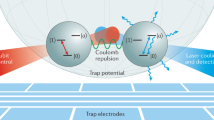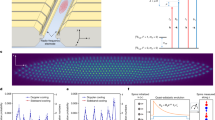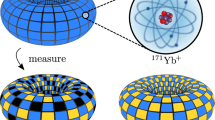Abstract
Entanglement—once only a subject of disputes about the foundation of quantum mechanics—has today become an essential issue in the emerging field of quantum information processing, promising a number of applications, including secure communication, teleportation and powerful quantum computation. Therefore, a focus of current experimental work in the field of quantum information is the creation and manipulation of entangled quantum systems. Here, we present our results on entangling two qubits in an ion-trap quantum processor not through a direct interaction of the ion qubits but instead through the action of a protocol known as entanglement swapping1. Our ion-trap system enables us to implement all steps of the entanglement swapping protocol in a fully deterministic way. Thus, two ion qubits can be prepared on demand in a well-defined entangled state. This particular feature may facilitate the implementation of quantum repeaters2 or aid in distributing entangled states in ion-trap quantum computers3.
This is a preview of subscription content, access via your institution
Access options
Subscribe to this journal
Receive 12 print issues and online access
$259.00 per year
only $21.58 per issue
Buy this article
- Purchase on SpringerLink
- Instant access to full article PDF
Prices may be subject to local taxes which are calculated during checkout



Similar content being viewed by others
References
Zukowski, M., Zeilinger, A., Horne, M. A. & Ekert, A. K. ‘Event-ready-detectors’ Bell experiment via entanglement swapping. Phys. Rev. Lett. 71, 4287–4290 (1993).
Briegel, H.-J., Dür, W., Cirac, J. I. & Zoller, P. Quantum repeaters: The role of imperfect local operations in quantum communication. Phys. Rev. Lett. 81, 5932–5935 (1998).
Kielpinski, D., Monroe, C. & Wineland, D. J. Architecture for a large-scale ion-trap quantum computer. Nature 417, 709–711 (2002).
Pan, J.-W., Bouwmeester, D., Weinfurter, H. & Zeilinger, A. Experimental entanglement swapping: Entangling photons that never interacted. Phys. Rev. Lett. 80, 3891–3894 (1998).
Halder, M. et al. Entangling independent photons by time measurement. Nature Phys. 3, 692–695 (2007).
Moehring, D. L. et al. Entanglement of single-atom quantum bits at a distance. Nature 449, 68–71 (2007).
Riebe, M. et al. Deterministic quantum teleportation with atoms. Nature 429, 734–737 (2004).
Barrett, M. D. et al. Deterministic quantum teleportation of atomic qubits. Nature 429, 737–739 (2004).
Reichle, R. et al. Experimental purification of two-atom entanglement. Nature 443, 838–841 (2006).
Schmidt-Kaler, F. et al. How to realize a universal quantum gate with trapped ions. Appl. Phys. B 77, 789–796 (2003).
Riebe, M. et al. Process tomography of ion trap quantum gates. Phys. Rev. Lett. 97, 220407 (2006).
Roos, C. F. et al. Bell states of atoms with ultralong lifetimes and their tomographic state analysis. Phys. Rev. Lett. 92, 220402 (2004).
Wootters, W. K. Entanglement of formation of an arbitrary state of two qubits. Phys. Rev. Lett. 80, 2245–2248 (1998).
Clauser, J. F., Horne, M. A., Shimony, A. & Holt, R. A. Proposed experiment to test local hidden-variable theories. Phys. Rev. Lett. 23, 880–884 (1969).
Boozer, A. D., Boca, A., Miller, R., Northup, T. E. & Kimble, H. J. Reversible state transfer between light and a single trapped atom. Phys. Rev. Lett. 98, 193601 (2007).
Cirac, J. I., Zoller, P., Kimble, H. J. & Mabuchi, H. Quantum state transfer and entanglement distribution among distant nodes in a quantum network. Phys. Rev. Lett. 78, 3221–3224 (1997).
Roos, C. F. et al. Control and measurement of three-qubit entangled states. Science 304, 1478–1480 (2004).
Hahn, E. L. Spin echoes. Phys. Rev. 80, 580–594 (1950).
Acknowledgements
We gratefully acknowledge support by the Austrian Science Fund (FWF), the European Commission (SCALA, CONQUEST networks) and the Institut für Quanteninformation GmbH. This material is based on work supported in part by the U.S. Army Research Office.
Author information
Authors and Affiliations
Corresponding author
Rights and permissions
About this article
Cite this article
Riebe, M., Monz, T., Kim, K. et al. Deterministic entanglement swapping with an ion-trap quantum computer. Nature Phys 4, 839–842 (2008). https://doi.org/10.1038/nphys1107
Received:
Accepted:
Published:
Issue date:
DOI: https://doi.org/10.1038/nphys1107
This article is cited by
-
Progress in quantum teleportation
Nature Reviews Physics (2023)
-
Probing tripartite entanglement and coherence dynamics in pure and mixed independent classical environments
Quantum Information Processing (2021)
-
Comparison the performance of five-qubit IBM quantum computers in terms of Bell states preparation
Quantum Information Processing (2020)
-
Demonstration of entanglement purification and swapping protocol to design quantum repeater in IBM quantum computer
Quantum Information Processing (2019)
-
A quantum repeater node with trapped ions: a realistic case example
Applied Physics B (2016)



